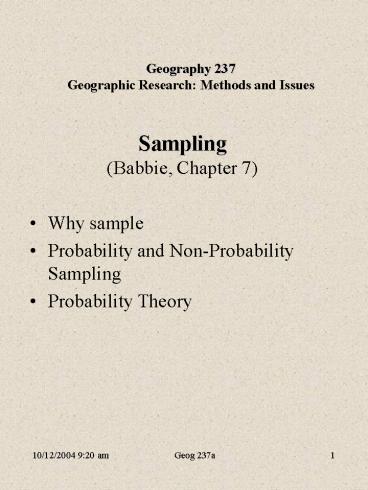Sampling (Babbie, Chapter 7) - PowerPoint PPT Presentation
1 / 27
Title:
Sampling (Babbie, Chapter 7)
Description:
Probability and Non-Probability Sampling. Probability Theory ... sample microcosm of population. same variation (e.g., gender, age, ethnicity) Avoid 'Bias' ... – PowerPoint PPT presentation
Number of Views:549
Avg rating:3.0/5.0
Title: Sampling (Babbie, Chapter 7)
1
Sampling(Babbie, Chapter 7)
Geography 237Geographic Research Methods and
Issues
- Why sample
- Probability and Non-Probability Sampling
- Probability Theory
2
Why Sample?
- What is a sample?
- Why do we sample in social research?
3
Two Classes of Sampling
- Non-Probability Sampling
- not based on probability theory
- representativeness not as important
- rapport difficult populations
- qualitative research
- e.g., snowball sampling
- Probability Sampling
- based on probability theory
- representativeness imperative
- e.g., simple random sample
4
Non-Probability Sampling
- Convenience Sample
- whomever is available
- pre-test a questionnaire
- e.g., students in geog237, attendees at the
Canadian Association of Geographers annual meeting
5
Non-Probability Sampling
- Purposive Sample
- units selected based on researcher judgment
- wide variety vs representative
- qualitative research
- e.g., most vocal people at a public meeting
6
Non-Probability Sampling
- Snowball Sample
- new respondents selected based on recommendation
of existing respondents - difficult populations
- rapport important
- e.g., homeless, members of activist group
7
Non-Probability Sampling
- Quota Sample
- representativeness important
- matrix theoretically important population
components - cells weightings same as sample
- e.g., see below sample of 1000, how many women
in Windsor?
City Men Women 0-50K 50K
London 45 55 60 40
Windsor 49 51 57 53
8
Non-Probability Sampling
- Key Informants
- insiders who know much about phenomenon of
interest - knowledgeable and articulate
- reconnaissance prior to contact with others
- help decide probability sampling scheme
- e.g., mayor and councilors to speak about
residents small town
9
Probability SamplingPrinciples/Terminology
- Representativeness
- sample microcosm of population
- same variation (e.g., gender, age, ethnicity)
- Avoid Bias
- selection bias those in sample not
representative of those in population - Equal Probability of Selection
- all members in population
- i.e., random selection
10
Probability SamplingProblems with These?
Source www.globeandmail.com
11
Probability SamplingPrinciples/Terminology
- Population
- group about whom you want to draw inferences
- more theoretical than quantifiable
- e.g., Ontarians, smokers
12
Probability SamplingPrinciples/Terminology
- Study Population
- group from which sample is actually drawn
- subset of population
- e.g., voters registered for 2003 provincial
election, people who buy cigarettes at stores in
London
13
Probability SamplingPrinciples/Terminology
- Sampling Frame
- the actual list from which elements are drawn
- e.g., voter registry list people observed buying
cigarettes - Sample
- subset of study population
- used for making statistical inferences
- e.g., 400 voters
14
Probability SamplingRelationship Between Terms
sample
sample frame
study population
population
15
Probability SamplingPrinciples/Terminology
- Element
- the unit that comprises the population, sample
population and the sample - typically the same as unit of analysis
- e.g., individuals, households
16
Probability SamplingSampling Distribution
- Parameter
- a number computed from a population
- a summary description of some aspect of a
population - no random variation true value
- often unknown (hence, the need to sample)
- e.g., median income of Canadians
17
Probability SamplingSampling Distribution
- Statistic
- a number computed from a sample
- meant to represent the corresponding population
parameter - random variation (sampling error)
- e.g., median income of 20 sample of Canadian
Census
18
Probability SamplingSampling Distribution
- Sampling Error
- How good are the results based on sample n?
- function of parameter, sample size, and standard
error - Standard Error
- average difference between a statistic and a
parameter - function of parameter and sample size
19
Probability SamplingSampling Distribution
20
Probability SamplingSampling Distribution
- Properties of Sampling Error
- as sample size increases standard error decreases
ˆ sampling error decreases - the greater the split in the parameter the
greater the standard error ˆ greater the sampling
error - i.e. more homogeneous populations have lower
sampling error
21
Probability SamplingTypes
- Simple Random Sample
- all elements in sample frame assigned numbers
- random numbers for sample chosen and applied to
list - e.g., random number tables, see next.
22
Probability SamplingSimple Random Sample
23
Probability SamplingSimple Random Sample
24
Probability SamplingTypes
- Systematic Sample
- practical alternative to simple random sampling
- every kth (sampling interval) element in a list
- typically total sample frame divided by sample
size to determine sampling interval - threat periodicity whereby k periodicity
- e.g., every other household (typically odd and
even numbers on same side of street!)
25
Probability SamplingSystematic Sample
26
Probability SamplingTypes
- Stratified (Random) Sample
- sample frame split into mutually exclusive
homogenous sub-groups - random or systematic sampling within these groups
- homogeneity of sub-groups reduces sampling error
- e.g., gender age categories census tracts in
London
27
Probability SamplingTypes
- (Multistage) Cluster Sample
- impractical to compile and count elements in a
single list (e.g., all Canadian university
students) - obtain lists for subgroups (i.e., all
universities) - randomly select some of the subgroups (e.g., 10
universities) - randomly select within those lists (i.e., simple
or systematic of 200 students) - total sample N 2000
28
Probability Sampling(Multistage) Cluster Sample































